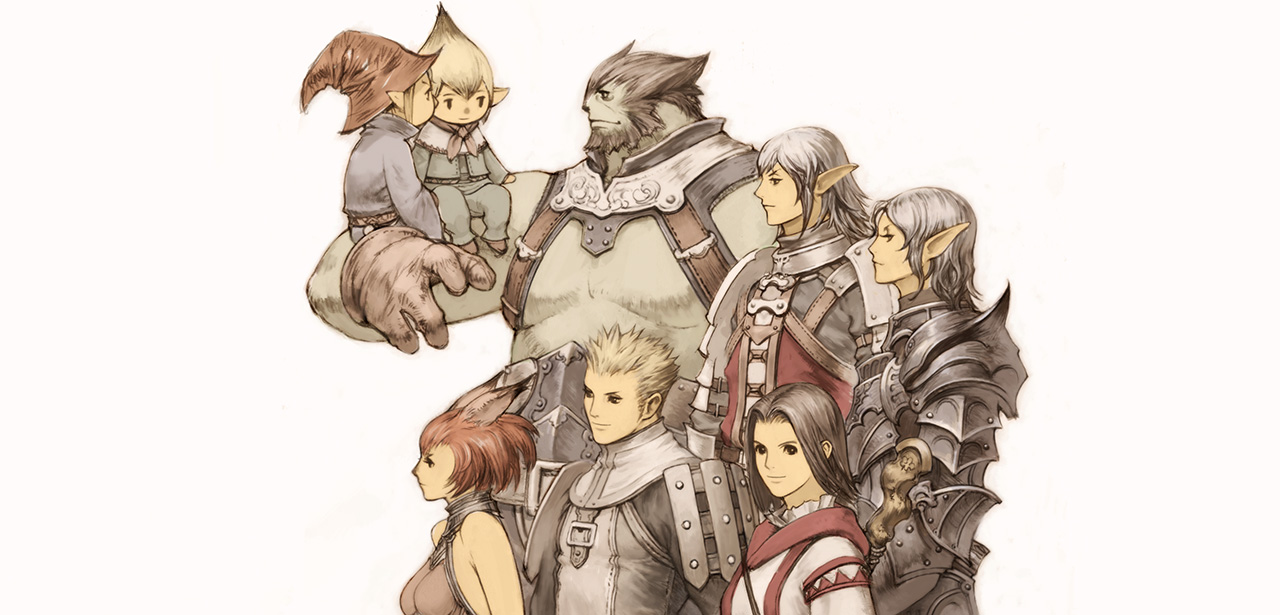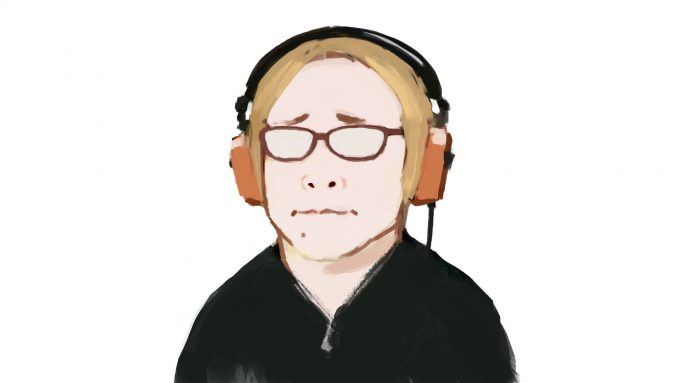WE GREW VANA’DIEL is a series of interviews with those who were involved in the development of FINAL FANTASY XI (FFXI), as well as guests from other companies. Our guest for this installment is Ryosuke Aiba, the original Art Director of FFXI who designed backgrounds and monsters, as well as the infamous subligar. How did Mr. Aiba come to join the FFXI team and design the world of Vana’diel In this second part, Mr. Aiba shared anecdotes from the early stages of FFXI’s development.

After joining Square in 1997, Mr. Aiba worked as a 2D and 3D artist for Xenogears and Chrono Cross. He was the first to assume the role of Art Director for FFXI and was involved in designing backgrounds, monsters, and character textures. Mr. Aiba then departed from Square Enix to join Hideo Minaba and others to found CyDesignation, Inc. in 2012, assuming the role of Director, where he has been involved in developing Rage of Bahamut and Project Awakening for Cygames.
Creating our own metaverse in FFXI
After development on Chrono Cross was finished, how did you end up joining the FFXI team?
- Aiba
After Chrono Cross was completed, I figured we’d be making a sequel for it and was making various preparations. One day, however, Mr. Tanaka* announced, “We’re not making a sequel to Chrono Cross, we’re going to make an MMORPG called FFXI!”
* Hiromichi Tanaka, original Producer for FFXI. What were your impressions of that at the time?
- Aiba
I remember thinking, “Whaaaat!?” It was just hard to fathom.
* "Snow Crash" is a science fiction novel published in 1992 by American author Neal Stephenson.
The term “metaverse,” which often comes up in the news lately, apparently originated from the science fiction novel “Snow Crash.”* I happened to be reading it at the time, and the realization that FFXI could be our chance to create our own metaverse helped me bounce back. Had you played any MMORPGs at that point?
- Aiba
I played Ultima Online* and EverQuest* after we were delegated to working on FFXI.
* Ultima Online is an MMORPG released in 1997 widely considered to be a pioneer of the genre.
* EverQuest is an MMORPG released in North America in 1999. What did you first work on in terms of graphics and art for FFXI?
- Aiba
We started with small tasks, such as creating characters and maps for testing purposes.
What aspects would you say you focused on the most?
- Aiba
Personally, I’d say I focused on the 2D art overall and character textures.
Regarding the textures, it was nice that we gained the ability to calculate light sources in real time, but the shading and textures of hand-drawn characters like those in Xenogears and Chrono Cross really didn’t mesh well with real-time lighting. Shading by calculations is effective when you can use a large number of polygons for a character, but not so much in the case of FFXI, where details are drawn in on 2D textures which are then pasted on to low-poly models. Figuring out how to make that work well was the most difficult part of the development process. How did you end up solving it?
- Aiba
We got creative with applying hand-drawn shadows onto textures, controlled the intensity of light and shadow, and added bias lighting. Hand-drawn textures were also created to break up the shadows that stretched along jagged polygons. As for light source calculations, some of them appear to be in error, but we made them as unobtrusive as possible.
Doing that for every single character and piece of equipment must’ve been a daunting task…
- Aiba
It was quite the challenge. (laughs wryly)
Although we had no problem creating a 3D world that could be viewed in 360 degrees, we struggled with the sheer vastness of FFXI’s world and number of objects within it. After all, the game had to run on the PlayStation 2’s four megabytes of video memory (VRAM). I’m sure my fellow staff members also struggled to come up with specifications that would make the world feel enormous but keep the data as small as possible. Even if hard disks could be used, the restrictions around memory must’ve been quite severe.
- Aiba
As a matter of fact, the original specifications were to have players choose from 32 predetermined appearances that wouldn’t reflect the equipment they were wearing. But we thought, “This is an MMORPG, you have to have visible equipment!” and managed to create a system for swapping equipment.
The feeling of being present in the world
The towns and fields of FFXI retain their unique atmospheres, and I feel that the in-game world hasn’t aged much even after 20 years. What would you say contributes to this feeling?
- Aiba
The FFXI team had staff members who worked on Xenogears and Chrono Cross, so just like with their previous works, I think everyone had the same desire to manipulate the in-game world with colors and texture. That’s probably what draws out the unique atmosphere. Everyone in the background team emphasized the feeling of actually being present in the virtual scenery.
FFXI’s overworld has aspects like the wind blowing or changing weather conditions, which helped reinforce the feeling that I was there. In La Theine Plateau, for example, I remember being impressed by the little discoveries scattered throughout the environment, like the dandelion-like plants floating in the sky and the rainbow that appears after rainy weather.
- Aiba
That’s something the background team was meticulous about, and we often talked about making the world feel as lively as possible rather than placing objects for the sake of doing so. The same applies to cities, which were large areas that could only hold so many objects due to memory limitations, where our goal was to create a lively landscape while reusing as many assets as possible.

On top of that, the three nations and Jeuno each have their own distinct atmosphere.
- Aiba
I believe we were consciously trying to differentiate each city from each other in the early stages of the project.
I’d also like to ask about the monsters. In FFXI, players fight monsters directly on the overworld rather than being transported into a battle encounter. Was there anything you found particularly memorable about creating monsters for such a system?
- Aiba
It was our first time developing an online game, so we had lots of ideas. Some included having monsters attack each other or lowering the number of spawns for the monsters being attacked. There was also an idea in the early stages where if a player was only defeating a specific type of monster, the surviving monsters would have their levels increased.
I remember the teaser video from the early stages of development had a scene where a Goobbue was preying on a Mandragora.
- Aiba
That was something we’d wanted to achieve in the game. The sense that certain monsters exist in certain terrain and climate in the actual game is a remnant of that idea.
What about creating NPCs?
- Aiba
I don’t want to speak out of turn and have the staff at the time thinking, “That’s wrong!” but I imagine they felt more enriched compared to their normal line of work.
To elaborate, the game development world strives to have specialists who work on very specific tasks, so it’s not rare to be assigned something like creating only the hand armor for various equipment sets, for example. In that regard, NPCs were created as a single unit from head to toe, so there was a joy in designing a full-on character rather than just their equipment. I remember it being a fun job, especially when the NPC had an important role or an outstanding line of dialogue, which made it a little more exciting. There are numerous NPCs in the game, but I remember hearing somewhere that Bahamut’s details were being worked out until the last minute. Which aspects of Bahamut were you meticulous about?
- Aiba
It wasn’t so much that I was ironing out his design till the last minute as it was that production took a while and ended up taking till the last minute. Bahamut was just too massive… (laughs wryly)
Bahamut was one of the largest entities in FFXI at that time. He didn’t even fit in your screen unless you stepped back quite a bit.
- Aiba
He was simply massive. But as far as production went, I enjoyed designing him from the very first drawing.
Was it more challenging to design boss monsters compared to regular monsters, considering how special they are?
- Aiba
Yes. I especially remember having fun designing Bahamut and the Shadow Lord since I liked them as characters too.

* Part 3 will be released on November 23, 2022.




